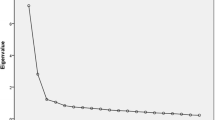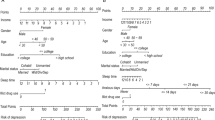Summary
A concordance analysis between the Center for Epidemiologic Studies Depression Scale (CES-D) and the National Institute of Mental Health (NIMH) Diagnostic Interview Schedule (DIS) for current major depression was conducted using data from Cuban Americans and Puerto Rican respondents to the Hispanic Health and Nutrition Examination Survey (HHANES). Overall agreement between the two depression measures was relatively high, which suggested that the CES-D might be appropriate as a first-stage screening instrument for community-based surveys of clinical depression. Female gender and indicators of social class (education, income, poverty index, and employment) were related to low specificity and low agreement. The estimated cutoff points of the CES-D that best predicted DIS current major depression were different between the two ethnic groups; 17 for Cuban Americans, and 20 for Puerto Ricans. A receiver operating characteristics (ROC) curve analysis revealed that the traditional method of defining CES-D cases by summing the scores for each item was superior to counting only the persistent symptoms, that is, those present nearly everyday.
Similar content being viewed by others
References
Regier DA et al (1988) One-month prevalence of mental disorders in the United States. Arch Gen Psychiatry 45:977–986
Weissman MM et al (1981) Depression and its treatment in a US urban community. Arch Gen Psychiatry 38:417–421
Kaplan HI, Benjamin JS (1991) Synopsis of psychiatry: behavioral science clinical psychiatry, 6th edn, Williams & Wilkins, Baltimore, Md.
Roberts RE et al (1990) Using the CES-D scale to screen for depression and anxiety: effects of language and ethnic status. Psychiatry Res 31:69–83
Blumenthal MD (1975) Measuring depressive symptomatology in a general population. Arch Gen Psychiatry 32:971–978
Comstock GW, Helsing KJ (1976) Symptoms of depression in two communities. Psychol Med 97:233–239
Radloff LS, Locke BZ (1986) The Community Mental Health Survey and the CES-D scale. In: Weissman MM, Myers JD, Ross CE (eds) Community surveys of psychiatric disorders, Rutgers University Press, New Brunswick, N.J.
Weissman MM et al (1977) Assessing depressive symptoms in five psychiatric populations: a validity study. Am J Epidemiol 106:203–213
Myers JK, Weissman MM (1980) Use of a self-report symptom scale to detect depression in a community sample. Am J Psychiatry 137:1081–1084
Robins LN et al (1981) The National Institute of Mental Health Diagnostic Interview Schedule: its history, characteristics, and validity. Arch Gen Psychiatry 38:381–389
Robins LN et al. (1988) The Composite International Diagnostic Interview: an epidemiological instrument suitable for use in different diagnostic systems and in different cultures. Arch Gen Psychiatry 45:1069–1074
Cooper B, Morgan HG (1973) Epidemiological psychiatry. Thomas, Springfield, Ill.
Dohrenwend BP, Dohrenwend BS (1982) Perspective on the past and future of psychiatric epidemiology. Am J Psychiatry 72:1271–1279
Kendall PC et al. (1987) Issues and recommendations regarding use of the Beck Depression Inventory. Cogn Ther Res 11:289–299
Newman SC et al (1990) The efficiency of two-phase designs in prevalence surveys of mental disorders. Psychol Med 20:183–193
Roberts RE et al (1991) Screening for adolescent depression: a comparison of depression scales. J Am Acad Child Adolesc Psychiatry 30:58–66
Parloff MB et al (1954) Comfort, effectiveness and self-awareness as criteria improvement in psychotherapy. Am J Psychiatry 111:343–352
Beck AT et al (1961) An inventory for measuring depression. Arch Gen Psychiatry 4:561–571
Zung WWK (1965) A self rating depression scale. Arch Gen Psychiatry 12:63–70
Roberts RE, Vernon SW (1983) The Center for Epidemiologic Studies Depression Scale: its use in a community sample. Am J Psychiatry 140:41–46
Craig TJ, Van Natta PA (1976) Prevalence and persistence of depressive symptoms in patient and community populations. Am J Psychiatry 133:1426–1429
Mościcki EK et al (1987) The Hispanic Health and Nutrition Examination Survey: depression among Mexican American, Cuban Americans, and Puerto Ricans. In: Gaviria M, Arana JD (eds) Health and behavior: research agenda for Hispanic The Simon Bolivar research monograph series No. 1. University of Illinois, Chicago
American Psychiatric Association (1980) Diagnostic and statistical manual of mental disorders, 3rd edn. American Psychiatric Association, Washington, DC
Hough RL et al (1982) Comparison of psychiatric screening questionnaires for primary care patients. Final report, National Institute of Mental Health contract no. 278-81-0036, Rockville, Maryland, USA
Zich JM et al (1990) Screening for depression in primary care clinics: the CES-D and BDI. Int J Psychiatry Med 20:259–277
Murphy JM (1990) Depression in the community: findings from the Stirling County study. Can J Psychiatry 35:390–396
Craig TJ, Van Natta PA (1979) Influence of demographic characteristics on two measures of depressive symptoms. Arch Gen Psychiatry 36:149–154
Dohrenwend BP, Crandell DL (1970) Psychiatric symptoms in community, clinic and mental hospital groups. Am J Psychiatry 36:1611–1621
National Center for Health Statistics (1985) Plan and operation of the Hispanic Health and Nutrition Examination Survey 1982 1984. US GPO, Washington, DC (Vital and health statistics, series 1, no. 19) [DHHS Pub No (PHS) 85-1321]
Narrow WE et al (1990) Depression among Cuban Americans: the Hispamic Health and Nutrition Examination Survey. Soc Psychiatry Psychiatr Epidemiol 25:260–268
Mościcki EK et al (1989) Depressive symptoms among Mexican Americans: the Hispanic Health and Nutrition Examination Survey. Am J Epidemiol 130:348–360
Eaton WW, Kessler LG (1981) Rate of symptoms of depression in a national sample. Am J Epidemiol 114:528–538
Roberts RE (1980) Reliability of the CES-D scale in different ethnic contexts. Psychiatry Res 2:125–133
Boyd JH et al (1982) Screening for depression in a community sample. Arch Gen Psychiatry 39:1195–1200
Regier DA et al (1984) The NIMH Epidemiologic Catchment Area Program: historical context, major objectives, and study population characteristics. Arch Gen Psychiatry 412:934–941
Eaton WW, Kessler LG (1985) Epidemiologic field methods in psychiatry: the NIMH Epidemiologic Catchment Area Program. Academic Press, Orlando, Fla.
Karno M et al. (1983) Development of the Spanish language version of the National Institute of Mental Health Diagnostic Interview Schedule. Arch Gen Psychiatry 40:1183–1188
Burnam MA et al (1983) The Spanish Diagnostic Interview Schedule. Arch Gen Psychiatry 40:1189–1196
Hsiao JK et al. (1989) Diagnosing diagnoses: receiver operating characteristics methods and psychiatry. Arch Gen Psychiatry 46:664–667
Gavin DR et al. (1989) Diagnostic validity of the drug abuse screening test in the assessment of DSM-III drug disorders. Br J Addict 84:301–307
Murphy JM et al (1987) Performance of screening and diagnostic tests: application of receiver operating characteristics analysis. Arch Gen Psychiatry 44:550–555
Weinstein MC et al (1989) A comparison of three psychiatric screening tests using receiver operating characteristics (ROC) analysis. Med Care 27:593–607
Ross HE, Glaser FB (1989) Psychiatric screening of alcohol and drug patients: the validity of the GHQ-60. Am J Drug Alcohol Abuse 15:429–442
Mari JDJ, Williams P (1985) A comparison of the validity of two psychiatric screening questionnaires (GHQ-12 and SRQ 20) in Brazil, using receiver operating characteristics (ROC) analysis. Psychol Med 15:651–659
Sackett DL et al (1991) Clinical epidemiology: a basic science for clinical medicine, 2nd edn, Little, Brown and Company, Boston, Mass.
Endicott J, Spitzer RL (1978) A diagnostic interview: the Schedule for Affective Disorders and Schizophrenia. Arch Gen Psychiatry 35:837–844
Deforge BR, Sobal J (1988) Self-report depression scales in the elderly: the relationship between the CES-D and Zung. Int J Psychiatry Med 18:325–338
Blumenthal MD, Dielman TE (1975) Depressive symptomatology and role function in a general population. Arch Gen Psychiatry 32:985–991
Schwab JJ et al (1967) Sociocultural aspects of depression in medical inpatients: I. frequency and social variables. Arch Gen Psychiatry 17:533–538
Hollingshead AB, Redlich FG (1958) Social class and mental illness. Wiley, New York.
Srole L et al (1962) Mental health in metropolis: the Midtown Manhattan Study. McGraw-Hill, New York
Crandell DL, Dohrenwend BP (1967) Some relations among psychiatric symptoms, organic illness and social scales. Am J Psychiatry 12:1527–1537
Derogatis LR et al (1971) Social class and race as mediator variables in neurotic symptomatology. Arch Gen Psychiatry 25:31–40
Hesbacher PT et al (1975) Social factors and neurotic symptoms in family practice. Am J Public Health 65:148–155
Vera M et al (1991) Depressive symptoms among Puerto Ricans: island poor compared with residents of the New York City area. Am J Epidemiol 134:502–510
Hankin JR, Locke BZ (1982) The persistence of depressive symptomatology among prepaid group practice enrollees: an exploratory study. Am J Public Health 72:1000–1006
Weissman MM et al (1986) Community surveys of psychiatric disorders. Rutgers University Press, New Brunswick, N.J.
Husaini BA et al (1980) Depression in rural communities: validating the CES-D scale. J Community Psychol 8:20–27
Parikh RM et al (1988) The sensitivity and specificity of the Center for Epidemiologic Studies Depression scale in screening for post-stroke depression. Int J Med 18:169–181
Angel R, Guarnaccia PJ (1990) Mind, body, and culture: somatization among Hispanics. Soc Sci Med 28:1229–1238
Guarnaccia PJ et al (1990) A critical review of epidemiological studies of Puerto Rican mental health. Am J Psychiatry 147:1449–1456
Fleiss JL (1981) Statistical methods for rates and proportions, 2nd edn. Wiley, New York
Carroll BJ et al (1973) Depression rating scales: a critical review. Arch Gen Psychiatry 28:361–366
Paykel ES, Pursoff BA (1973) Response set and observer set in the assessment of depressed patients. Psychol Med 3:209–216
Author information
Authors and Affiliations
Rights and permissions
About this article
Cite this article
Cho, M.J., Mościcki, E.K., Narrow, W.E. et al. Concordance between two measures of depression in the Hispanic Health and Nutrition Examination Survey. Soc Psychiatry Psychiatr Epidemiol 28, 156–163 (1993). https://doi.org/10.1007/BF00797317
Accepted:
Issue Date:
DOI: https://doi.org/10.1007/BF00797317




